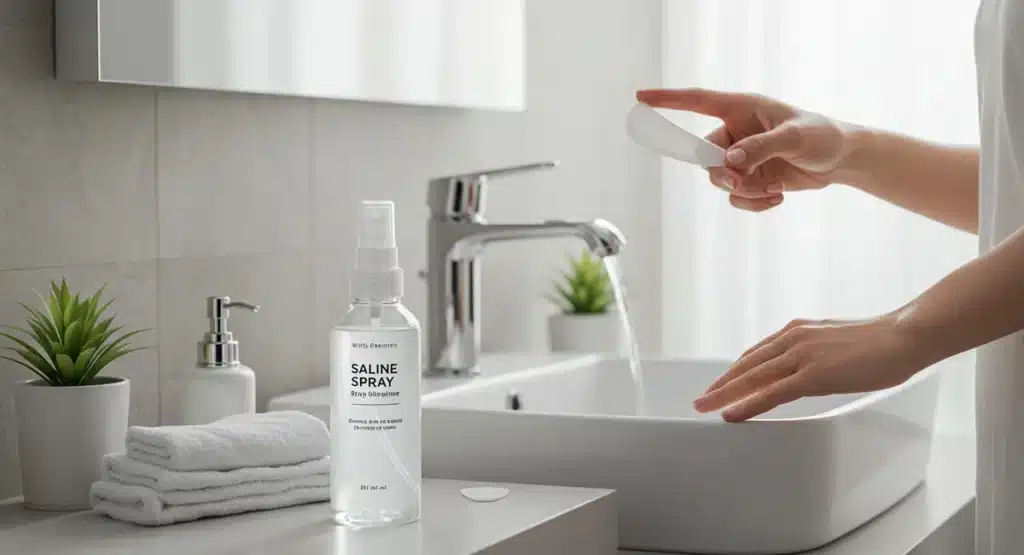Saline Spray: The Gentle and Natural Nasal Care Solution
Saline spray is a gentle mist containing a simple mix of water and salt (sodium chloride). Unlike medicated nasal sprays, it’s non-medicated, non-addictive, and ideal to clear, soothe, and maintain your nasal passages naturally. It’s commonly used for:
- Hydrating dry nasal passages
- Easing congestion from colds, allergies, or irritation
- Improving breathing and restoring nasal function
Why Use Saline Spray? Top Benefits
Moisturizes Nasal Membranes
- Helps combat dryness from air-conditioning, heating, or arid climates.
- Keeps mucous membranes supple and less prone to crusting or bleeding.
Clears Pathogens and Allergens
- Gently rinses pollen, dust mites, pollutants, and bacteria away.
- Promotes natural clearance via cilia function.
Soothes Sinus Congestion & Pressure
- Loosens mucus, making it easier to expel.
- Reduces sinus pressure and eases breathing.
Safe for All Ages
Approved for use from newborns to older adults. Non-dependence risk makes it ideal for long-term use—even daily.
Complement to Treatments
Enhances performance of nasal steroids and decongestants. Helps avoid overuse of medications like Afrin, which can cause rebound congestion.
How Saline Spray Works: The Science
Tonicity
- Isotonic (0.9% salt): Gentle and similar to bodily fluids.
- Hypertonic (1.5–3% salt): Draws fluid out from swollen tissues—helpful for congestion.
It physically flushes your nasal cavity, lifting away irritants and restoring moisture.
How to Choose the Right Saline Spray
1. Tonicity
- Choose isotonic for daily hydration (e.g., for dry climates or frequent flights).
- Choose hypertonic for decongestion (e.g., during sinus infections).
2. Delivery Method
- Nasal mist (spray): Easy, compact, great for travel.
- Sniff bottles: Squeeze alternative.
- Neti-pot/Bulb syringe: Requires preparation, deeper rinse, ideal for sinus issues.
3. Preservatives
- Preservative-free: Ideal for babies or those prone to nasal irritation.
- Preserved: Longer shelf-life, convenient for occasional use.
4. Brand Clarity
Popular brands: NeilMed, Simply Saline, Ayr — but clear labels matter more than names. Ensure 0.9% sodium chloride for isotonic or 1.5–3% for hypertonic.
How to Use Saline Spray: Step-by-Step Guide
1. Preparation
- Wash hands thoroughly.
- Gently blow your nose to clear large clots.
2. Position Yourself
- Sit upright or lean forward slightly.
- Tilt your head forward by ~30°—never backward to avoid throat drainage.
3. Insert and Spray
- Insert tip into one nostril—aim slightly outward (toward the ear).
- Squeeze gently: 1–2 sprays.
- Exhale gently through your mouth.
4. Follow-up
- Blow your nose gently again to expel loosened mucus.
- For bulb or neti-pot: rinse, then dry/air-dry and store.
5. Use as Needed
For hydration: up to 4–6 times daily.
For congestion relief: 2–3 times daily.
Safe for babies under pediatrician’s guidance—use as directed.
Safety & Precautions
- Avoid after nasal surgery unless approved by a doctor.
- Use distilled, sterile, or boiled water for homemade saline.
- Discard saline after opening (usually 30 days).
- Watch for contamination: toss if cloudy or smells unusual.
- Mild sting? Use isotonic saline—hypertonic can sting if sensitive.
DIY Saline Spray Recipe
Ingredients:
- 1 cup distilled or sterilized water
- ½ teaspoon baking soda
- ½ teaspoon non-iodized salt
Steps:
- Boil water; let cool to body temperature.
- Stir in salt and baking soda until dissolved.
- Use a clean bottle and dropper nozzle.
- Store in the fridge; use within 7 days.
Who Should Use Saline Spray?
- Allergy sufferers
- Dry-air dwellers
- Frequent fliers
- CPAP/BiPAP users
- Parents of congested infants
- People prone to nosebleeds or sinus discomfort
Comparisons: Is Saline Spray Better Than?
| Condition/Need | Saline Only | Saline + Nasal Steroid | Decongestant Only (+Saline) |
|---|---|---|---|
| Regular hydration | ✅ Yes | ✅ Yes | ❌ Not ideal |
| Allergy relief | Good | Better (with steroid) | Short-lived relief |
| Sinus infection | Aid in flushing | Essential + supportive | Temporary open relief |
| Medication dependency risk | None | Low | High if overused |
| Ideal for infants/elderly | Yes | With approval | Caution—risk of side effects |
When to Seek Medical Help
- Severe or increased facial pressure
- High fever or prolonged symptoms >10 days
- Yellow/green discharge
- Nosebleeds, dizziness, or visual disturbances
- Post-surgical or chronic sinus conditions
- Infant with difficulty feeding or breathing
Tips to Maximize Effectiveness
- Warm solution to ~body temp for comfort.
- Maintain bottle hygiene.
- Use with a humidifier in dry environments.
- Use before medications for better absorption.
- Bring during travel to prevent dryness.
Conclusion
Saline spray is a simple, safe, and effective tool for daily nasal care. Whether for hydration, congestion relief, or allergy support, it’s an essential addition to your health routine.






